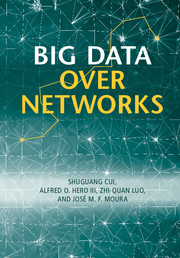Book contents
- Frontmatter
- Contents
- List of contributors
- Preface
- Part I Mathematical foundations
- Part II Big data over cyber networks
- Part III Big data over social networks
- 9 Big data: a new perspective on cities
- 10 High-dimensional network analytics: mapping topic networks in Twitter data during the Arab Spring
- 11 Social influence analysis in the big data era: a review
- Part IV Big data over biological networks
- Index
- References
9 - Big data: a new perspective on cities
from Part III - Big data over social networks
Published online by Cambridge University Press: 18 December 2015
- Frontmatter
- Contents
- List of contributors
- Preface
- Part I Mathematical foundations
- Part II Big data over cyber networks
- Part III Big data over social networks
- 9 Big data: a new perspective on cities
- 10 High-dimensional network analytics: mapping topic networks in Twitter data during the Arab Spring
- 11 Social influence analysis in the big data era: a review
- Part IV Big data over biological networks
- Index
- References
Summary
The recent availability of large amounts of data for urban systems opens the exciting possibility of a new science of cities. These datasets can roughly be divided into three large categories according to their time scale. We will illustrate each category by an example on a particular aspect of cities. At small time scales (of order a day or less), mobility data provided by cell phones and GPS reveal urban mobility patterns but also provide information about the spatial organization of urban systems. At very large scales, the digitalization of historical maps allows us to study the evolution of infrastructure such as road networks, and permits us to distinguish on a quantitative basis self-organized growth from top-down central planning. Finally at intermediate time scales, we will show how socio-economical series provide a nice test for modeling and identifying fundamental mechanisms governing the structure and evolution of urban systems. All these examples illustrate, at various degrees, how the empirical analysis of data can help in constructing a theoretically solid approach to urban systems, and to understand the elementary mechanisms that govern urbanization leaving out specific historical, geographical, social, or cultural factors. At this period of human history that experiences rapid urban expansion, such a scientific approach appears more important than ever in order to understand the impact of current urban planning decisions on the future evolution of cities.
Big data and urban systems
A common trait shared by all complex systems – including cities – is the existence of a large variety of processes occurring over awide range of time and spatial scales.The main obstacle to the understanding of these systems therefore resides at least in uncovering the hierarchy of processes and in singling out the few that govern their dynamics. Albeit difficult, the hierarchization of processes is of prime importance. A failure to do so leads either to modelswhich are too complex to give any real insight into the phenomenon or to be validated, or too simple to provide a satisfactory framework which can be built upon. As a matter of fact, despite numerous attempts [1–6], a theoretical understanding of many observed empirical regularities in cities is still missing. This situation is, however, changing with the recent availability of an unprecedented amount of data about cities and their inhabitants.
- Type
- Chapter
- Information
- Big Data over Networks , pp. 247 - 277Publisher: Cambridge University PressPrint publication year: 2016

